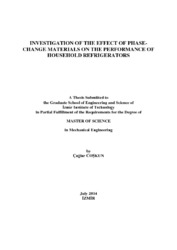Please use this identifier to cite or link to this item:
https://hdl.handle.net/11147/4230Full metadata record
| DC Field | Value | Language |
|---|---|---|
| dc.contributor.advisor | Özkol, Ünver | - |
| dc.contributor.author | Coşkun, Çağlar | - |
| dc.date.accessioned | 2014-12-04T09:56:26Z | - |
| dc.date.available | 2014-12-04T09:56:26Z | - |
| dc.date.issued | 2014-07 | - |
| dc.identifier.uri | http://hdl.handle.net/11147/4230 | - |
| dc.description | Thesis (Master)--Izmir Institute of Technology, Mechanical Engineering, Izmir, 2014 | en_US |
| dc.description | Includes bibliographical references (leaves: 92-94) | en_US |
| dc.description | Text in English; Abstract: Turkish and English | en_US |
| dc.description | Full text release delayed at author's request until 2016.08.11 | en_US |
| dc.description.abstract | The main problem that this study deals with is the issues of thermal effectiveness of phase change materials (or PCM) application to household refrigerators and investigating the performance improvement with numerical methods. PCMs are materials that store thermal energy in latent heat form between its solidus and liquidus points. By this way, these materials can store large amount of heat in a narrow temperature range, which made them to gain popularity in recent years. By exploiting this feature of PCMs, it is thought that using these materials in household refrigerators could increase the energy efficiency, thus energy class of a refrigerator. Because, keeping the cold energy inside the refrigerated space as latent heat will decrease the number of stop and start cycles of the compressor. Decreasing the number of stop and start cycles is beneficial since the distribution of refrigerant fluid in the refrigeration cycle breaks down every time compressor is stopped and established again on the next start, which is the main inefficiency source. In this study, at first, the steady temperature contours are extracted by steady state numerical simulations to see the possible locations for the application of PCMs. Then, transient simulations are conducted to understand the transient thermal behavior of the refrigerated space and these transient results are validated with experimental data. In the light of these steady and transient thermal pictures, PCMs having proper phase change temperatures are placed in appropriate places on the walls of the refrigerator and transient simulations are conducted to see the effects of PCMs. Since radiative heat transfer cannot be ignored in household refrigerators, all simulations are conducted with and without radiation and effects of radiation are also presented. The well – known commercial computational fluid dynamics (CFD) code, FLUENT is employed for the numerical simulations. | en_US |
| dc.language.iso | en | en_US |
| dc.publisher | Izmir Institute of Technology | en_US |
| dc.rights | info:eu-repo/semantics/openAccess | en_US |
| dc.subject | Phase change materials | en_US |
| dc.subject | Household refrigerators | en_US |
| dc.subject.lcsh | Refrigeration and refrigerating machinery | en_US |
| dc.title | Investigation of the effect of pase-change metarials on the performance of household refrigerators | en_US |
| dc.title.alternative | Faz değişken malzemelerin ev tipi buzdolaplarının performansına olan etkisinin incelenmesi | en_US |
| dc.type | Master Thesis | en_US |
| dc.authorid | TR191336 | en_US |
| dc.institutionauthor | Coşkun, Çağlar | - |
| dc.department | Thesis (Master)--İzmir Institute of Technology, Mechanical Engineering | en_US |
| dc.relation.publicationcategory | Tez | en_US |
| item.languageiso639-1 | en | - |
| item.fulltext | With Fulltext | - |
| item.openairecristype | http://purl.org/coar/resource_type/c_18cf | - |
| item.openairetype | Master Thesis | - |
| item.grantfulltext | open | - |
| item.cerifentitytype | Publications | - |
| Appears in Collections: | Master Degree / Yüksek Lisans Tezleri | |
Files in This Item:
| File | Description | Size | Format | |
|---|---|---|---|---|
| 10013276.pdf | MasterThesis | 4.29 MB | Adobe PDF |  View/Open |
CORE Recommender
Page view(s)
114
checked on Jul 22, 2024
Download(s)
36
checked on Jul 22, 2024
Google ScholarTM
Check
Items in GCRIS Repository are protected by copyright, with all rights reserved, unless otherwise indicated.